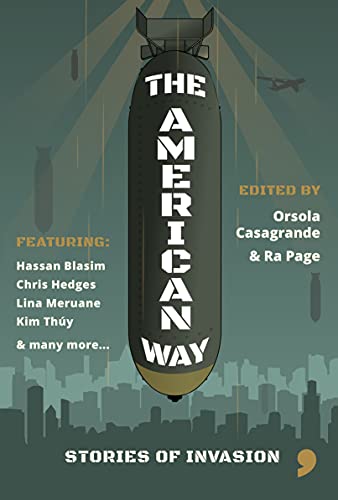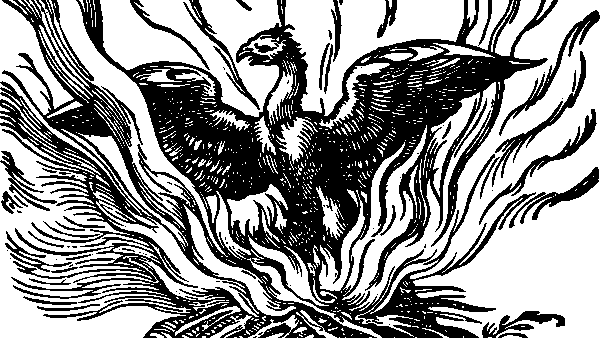This new short story collection by Comma Press focuses on what the American Way looks like to those at the sharp end of US aggression around the world.
“The American Way” is a phrase that shifts in meaning depending on where in the world you live and on how much power you have.
To many people inside the US, it means life, liberty and the pursuit of happiness. Individualism, hard work, pulling yourself up by your bootstraps and living the American Dream. But to the countless victims of US state power both at home and abroad, it means something very different.
This new short story collection by Comma Press focuses on what the American Way looks like to those at the sharp end of US aggression around the world. There are stories from Iran, Congo, Cuba, Vietnam, Chile, El Salvador, Grenada, Afghanistan, Iraq, Gaza, Libya, Pakistan and plenty more: altogether the book includes 20 examples of brutal and disastrous US interventions in other countries—which, as the editors note in their introduction, is just scratching the surface.
What’s interesting about this collection is that it shows the human impact of US foreign policy through short stories by writers from the country concerned. Too often, these episodes get reduced to a brutal shorthand: Abu Ghraib, Bay of Pigs, El Mozote. Allende, Lumumba, Mossadegh. These stories show us what it was actually like to be an ordinary person living through these extraordinary historic events.
That’s what fiction is good at: getting beyond the basic historical facts and showing us the human impact by telling us a good story. But those facts are also important, so after each story, there’s also an afterword by a historian or other expert explaining the context of the story and how it fits in with what actually happened in those places at those times.
This unusual format worked really well for me. Having the facts explained afterwards frees up the fiction writers to just tell the story, without having to cram in too much exposition. And the afterwords were very informative—even though I was already familiar with most of the events, I learnt something new from each of them.
Some of the events covered in the book were completely new to me as well. I was puzzled at first to see countries like Italy and Canada featured in the book—I had no idea that the CIA sponsored Italian fascists to plant deadly bombs in Italian cities, or that they funded gruesome mind-control experiments on Canadian psychiatric patients. The afterwords provided the historical context and sources for events that would otherwise have seemed hard to believe.
As for the stories themselves, they vary quite a bit in style and approach. Fiston Mwanza Mujila applies the dark humour that I recognise from his novel Tram 83 to a story about an unemployed miner who makes his fortune by cashing in on the nostalgia for Patrice Lumumba after his CIA-orchestrated murder. Jacob Ross shows us what the US invasion of Grenada looked like from the perspective of a mother trying to protect her son. Hassan Blasim imagines a drug-fuelled confrontation between a man who was tortured by US soldiers in Abu Ghraib and an older man who was tortured by Iraqis under the rule of Saddam Hussein.

Perhaps the most moving story of all is A Bird With One Wing by Bina Shah, which explores in detail what a drone strike on a wedding party actually looks and feels like. At the same time, we get a real feeling for what life is like for Zarghuna, a child bride and the mother of a child with Down’s Syndrome in a remote village in North Waziristan, and now the victim of a sudden flash of death from the sky.
The most effective stories are those that, like the examples I just mentioned, focus on telling a good story and leave the historical exposition for the afterword. Not all the stories get that balance right—some of them are barely stories at all but feel more like dialogues, with the characters acting as unconvincing representatives of political positions or as explainers of historical context.
But the failures were a minority for me. Overall, The American Way is an innovative fictional exploration of some of the well-known and lesser-known episodes of US aggression around the world. The stories bring the human impact of these events to life, while the afterwords will give new details even to those already familiar with the general history.
If you still think of the American Way as something positive, this book would be a good corrective. That’s not to say that America is all bad either—just that there’s a dark side to its power that often gets overlooked. As we saw in my recent post on the Amritsar massacre and the British Empire’s policy of “exemplary violence”, imperial projects tend to be built on violence and fear in order to keep control of huge numbers of people with minimal manpower. This book, like the Amritsar one, shows us the human cost of these projects and reminds us that it’s simply not acceptable.





There are 2 comments
Sheesh. What a chilling photograph. I’ve never seen that before.
One name amongst the list of contributors immediately jumps out at me, Kim Thuy’s, as I’ve just copied out several passages from her recent book Em. Her books are very short and have that sense of being polished; as such, she often says very straightforward and simple things that you can’t stop turning over the words in your mind. It’s a style that suits subject matter like this. So if any of the other writers included here, are as talented and dedicated as she is, I’m definitely interested.
Yes, it’s a horrific photo, isn’t it? Not just the torture and humiliation, but the soldiers with their goofy grins and poses, like this is all so much fun. Unfortunately, there were a lot like this to choose from.
To be honest, Thuy’s wasn’t my favourite story. It felt more like a novel synopsis than a short story, covering a huge amount of ground without ever really getting into a scene or dialogue. There were some impressive turns of phrase, but it didn’t work for me as a whole. But maybe you’ll have a different reaction. I’d be interested to hear what you think if you do end up reading it!